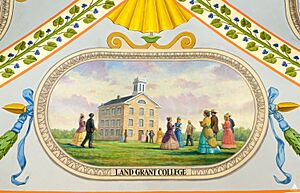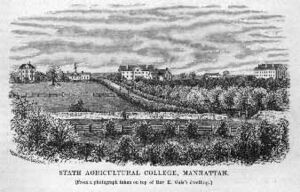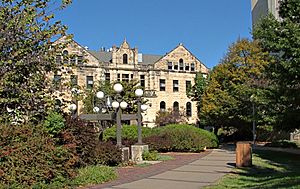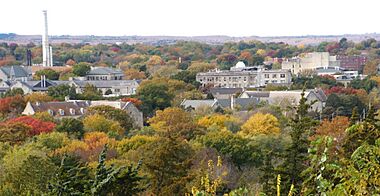Kansas State University facts for kids
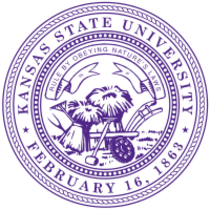 |
|
|
Former names
|
Kansas State Agricultural College (1863–1931) Kansas State College of Agriculture and Applied Science (1931–1959) |
|---|---|
| Motto | "Rule by Obeying Nature's Laws" |
| Type | Public land-grant research university |
| Established | February 16, 1863 |
|
Parent institution
|
Kansas Board of Regents |
| Accreditation | HLC |
|
Academic affiliations
|
|
| Endowment | $849.0 million (FY2024) |
| President | Richard Linton |
| Provost | Jesse Perez Mendez |
|
Academic staff
|
1,404 |
| Students | 20,295 (fall 2024) |
| Undergraduates | 15,650 (fall 2024) |
| Location |
,
,
United States
39°11′29″N 96°34′51″W / 39.1914°N 96.5809°W |
| Campus | Small city, 668 acres (2.70 km2) |
| Other campuses | |
| Newspaper | Kansas State Collegian |
| Colors | Royal Purple |
| Nickname | Wildcats |
|
Sporting affiliations
|
NCAA Division I FBS – Big 12 |
| Mascot | Willie the Wildcat |
 |
|
Kansas State University (often called KSU, Kansas State, or K-State) is a large public university. Its main campus is in Manhattan, Kansas, in the United States. It was the first public college in Kansas. It opened in 1863 as a "land-grant" college. This means the U.S. government gave land to the state to help create a college focused on agriculture and mechanical arts. K-State had over 20,000 students in Fall 2024.
The university is known for its high level of research. It offers many different study programs through its nine colleges. These include the College of Veterinary Medicine and the College of Technology and Aviation. Students can earn master's and doctoral degrees in many subjects. K-State also has other campuses in Salina and Olathe. The Salina campus focuses on aerospace and technology. The Olathe campus focuses on advanced studies in areas like animal health and food safety.
Contents
University History
| Naming History | |
| Years | Name |
|---|---|
| 1863–1931 | Kansas State Agricultural College |
| 1931–1959 | Kansas State College of Agriculture and Applied Science |
| 1959–present | Kansas State University of Agriculture and Applied Science (Kansas State University in modern naming practice) |
Kansas State University started as the Kansas State Agricultural College. It was founded on February 16, 1863, during the American Civil War. It was the first college created under the Morrill Land-Grant Colleges Act. This act helped states set up colleges that taught practical subjects like farming and engineering. K-State is the third-oldest school in the Big 12 Conference. It is also the oldest public college in Kansas.
The idea for the school began in 1861, when Kansas became a state. Lawmakers wanted to create a state university. A group from Manhattan, led by Isaac Goodnow, suggested turning a private school called Blue Mont Central College into the state university. After a few tries, the state finally agreed on February 16, 1863. They accepted Manhattan's offer to donate the Blue Mont College buildings and land. This is how Kansas State University began.
When the college opened on September 2, 1863, it was one of the first public colleges in the U.S. to accept both women and men equally. In its first year, 52 students enrolled: 26 men and 26 women. In 1875, the university moved its main campus to its current location. The original site is now home to a bank and apartments.
In its early years, there was a debate about what the college should teach. Some thought it should only focus on farming. Others believed it should offer a wider range of subjects, like a full liberal arts education. For example, President George Fairchild (1879–1897) believed in a broader education. He famously said, "Our college exists not so much to make men farmers as to make farmers men."
In 1873, Kansas State was one of the first colleges to offer home economics. This program taught women practical skills for managing a home.
In 1931, the school's name changed to Kansas State College of Agriculture and Applied Science. In 1959, the Kansas legislature changed the name again to Kansas State University of Agriculture and Applied Science. This new name showed that the university was offering more advanced degree programs. Today, it is usually just called Kansas State University.
In 2010, President Kirk Schulz started the "K-State 2025" plan. This plan aimed to make K-State one of the top 50 research universities in the country by 2025. In 2011, the Olathe campus opened. Later, General Richard Myers became the university's 14th president. He was followed by Richard Linton.
Oldest Public University in Kansas
Kansas State was the first public college founded in the state. It began teaching college-level classes in 1863. The University of Kansas opened later, in 1866. It only offered basic, preparatory classes until 1869, when it started college-level courses.
K-State was created to teach agriculture, science, military science, and literature. This was in line with its role as a land-grant college. It was officially renamed Kansas State University in 1959.
University Campus
The main campus of Kansas State University in Manhattan covers about 668 acres (2.7 square kilometers). The campus has many historic buildings. It has more buildings built before 1910 than any other campus in Kansas. Holtz Hall, built in 1876, is the oldest stand-alone building. However, the oldest part of any building is in Seaton Hall, which was built even earlier.
Many buildings on campus are made of local limestone. The most famous building is Anderson Hall. It was built between 1877 and 1885. Anderson Hall is now on the National Register of Historic Places. It has been the university's main office building for over 100 years. Dickens Hall, built in 1908, houses the statistics and philosophy departments. Even with many old buildings, K-State has added over two million square feet of new buildings since 1986. These include a larger library, a new art museum, and a plant sciences building.
In June 2008, a strong tornado caused over $20 million in damage to several campus buildings. Since 2014, the main campus has been updated. Many small roads have been closed to cars to make the campus more friendly for walking.
Academic Programs
Kansas State University is known for its strong academic programs. Since 1986, it has ranked first among public universities for students winning major national scholarships. These include the Rhodes, Marshall, Truman, Goldwater, and Udall scholarships. K-State is also home to the Kansas Beta chapter of the Phi Beta Kappa honor society, which recognizes excellent students.
The university has 65 academic departments spread across nine colleges. These colleges include:
- Agriculture
- Architecture, Planning and Design
- Arts and Sciences
- Business Administration
- Education
- Engineering
- Health and Human Sciences
- Technology and Aviation
- Veterinary Medicine
The graduate school offers 65 master's degree programs and nearly 50 doctoral programs.
In 1991, the Kansas Technical Institute in Salina, Kansas joined Kansas State University. This became the College of Technology and Aviation at the Salina campus. In 2021, this campus was renamed the Kansas State University Salina Aerospace and Technology Campus. In 2018, the College of Engineering was renamed the Carl R. Ice College of Engineering.
Research at K-State
K-State is a major research university. It has many facilities where scientists work on important projects.
Agricultural Research
The university has always been very interested in agriculture. This includes studying plants and animals found in the Great Plains. The Kansas State University Gardens on campus are used for teaching and research about plants. The Konza Prairie is a large natural grassland preserve near Manhattan. It is used by the biology department for field research. The university also owns more land across the state. This land is used for Agricultural Experiment Stations in different cities.
In 2006, K-State opened the Biosecurity Research Institute (BRI). This is a very safe and secure place where scientists can study dangerous germs. It is designed for high-level research to protect against diseases.
The university also has other research centers. These include the James R. Macdonald Laboratory, which studies tiny particles like atoms. There is also a NASA Center for Gravitational Studies. K-State researchers helped develop the excimer laser, which is used in LASIK eye surgery.
Radio and Television History
Kansas State was involved in early experiments with radio and television. In 1912, K-State's experimental radio station 9YV began broadcasting the weather forecast daily. This made it the first radio station in the U.S. to have a regular weather show. Later, in 1924, the university got a license for a stronger radio station, KSAC. It broadcast until 2002.
In 1932, Kansas State was granted a license for the television station W9XAK. This was the first television station in Kansas. The station produced its own programs three nights a week. In 1939, it broadcast a football game between Kansas State and Nebraska. This was only the second college football game ever shown on TV. The station stopped broadcasting later that year.
K-State Research Exchange
The K-State Research Exchange, or K-REx, is an online system where Kansas State University stores research. Graduate students must submit their theses and dissertations electronically. These are then made available to the public through K-REx. This means anyone can find and read their research online.
Campus Life
| Race and ethnicity | Total | ||
|---|---|---|---|
| White | 80% |
|
|
| Hispanic | 9% |
|
|
| Two or more races | 4% |
|
|
| Black | 3% |
|
|
| Asian | 2% |
|
|
| International student | 2% |
|
|
| Unknown | 1% |
|
|
| Economic diversity | |||
| Low-income | 20% |
|
|
| Affluent | 80% |
|
|
Kansas State University has several museums on campus. These include the Marianna Kistler Beach Museum of Art, the KSU Historic Costume and Textiles Museum, and the K-State Insect Zoo. The university also hosts concerts, plays, and dance performances at McCain Auditorium.
From 1963 to 1997, the university had a lecture series that brought famous people to campus. Speakers included Martin Luther King Jr., Supreme Court Justices, and important thinkers.
Student Life
K-State has twelve residence halls where students can live on campus. These include Boyd Hall, Ford Hall, Goodnow Hall, Haymaker Hall, Marlatt Hall, Moore Hall, West Hall, Putnam Hall, Van Zile Hall, and the new Wefald Hall. There are also apartment-style living options. Some halls used to be only for women or men, but many are now co-educational.
In 1999, K-State started an academic honor code. Students promise to follow the Honor Pledge: "On my honor, as a student, I have neither given nor received unauthorized aid on this academic work."
Kansas State has over 400 student organizations. These groups allow students to join clubs based on their interests.
Student media includes the radio station KSDB-FM "Wildcat 91.9", the TV station KKSU-LD "Channel 8", the student newspaper Kansas State Collegian, and the Royal Purple Yearbook.
The official school song is "Alma Mater." It was written in 1888. Students and alumni sing it at most K-State sports events. "Wildcat Victory" and "Wabash Cannonball" are popular fight songs.
Fraternities and Sororities
Kansas State University has many national and international fraternities and sororities. These are social organizations that students can join.
Athletics
Sports began at Kansas State in the 1890s. The school's sports teams are called the Wildcats. They compete in the NCAA Division I and are part of the Big 12 Conference. The official school color is Royal Purple. White and silver are also often used. The athletics logo is a stylized Wildcat head, called the "Powercat."
K-State offers many sports, including football, basketball, cross country, track, baseball, golf, tennis, rowing, women's soccer, and volleyball. The head football coach is Chris Klieman. The head men's basketball coach is Jerome Tang. The head women's basketball coach is Jeff Mittie. The head baseball coach is Pete Hughes. In the 2012–2013 school year, Kansas State won conference titles in football, men's basketball, and baseball. This was a rare achievement for a Big 12 school.
Historically, Kansas State was important in breaking racial barriers in college sports. Harold Robinson was the first African-American athlete in the Big Seven Conference to receive a scholarship. He played football for K-State in 1949. Later, Earl Woods broke the baseball color barrier in 1951. Gene Wilson broke the basketball color barrier in 1951–1952.
Notable People
Alumni
Many Kansas State graduates have gone on to have successful careers. These include Sam Brownback, who was the 46th Governor of Kansas and later a U.S. Ambassador. Pat Roberts served as a U.S. Senator from Kansas. K-State alumni have also become university presidents, been inducted into the Rock and Roll Hall of Fame and the College Football Hall of Fame, and won Emmy Awards and Olympic gold medals. Geraldine L. Richmond, a famous scientist, received her chemistry degree from K-State in 1975.
Faculty
Many important teachers and researchers have worked at Kansas State. In its early years, faculty members were experts in agriculture, science, and military studies. For example, famous geologist Benjamin Franklin Mudge led the geology department. Army officer Andrew Summers Rowan taught military tactics.
Kansas State faculty have also won major awards. Fred Albert Shannon won the Pulitzer Prize for History in 1929 while teaching history at K-State. In 2008, Michael Wesch was named national Professor of the Year. At least eight K-State faculty members have gone on to become university presidents.
|
See also
 In Spanish: Universidad Estatal de Kansas para niños
In Spanish: Universidad Estatal de Kansas para niños


